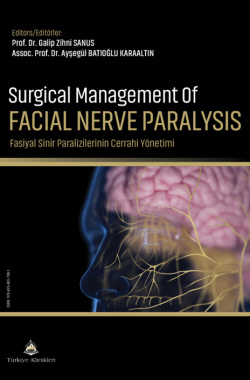The Concept of Three Corner Approach in Facial Reanimation; Restore the Balance, Restore the Volume and Restore the Animation
Mehmet Veli KARAALTINa, Ahmet Hamdi SAKARYAb, Cem PAYASLIb
aNişantaşı University Health Vocational School, Department of Operation Room Services, İstanbul, Türkiye
bPrivate Physician, İstanbul, Türkiye
Karaaltın MV, Sakarya AH, Payaslı C. The concept of three corner approach in facial reanimation; restore the balance, restore the volume and restore the animation. In: Sanus GZ, Batıoğlu Karaaltın A, eds. Surgical Management of Facial Nerve Paralysis. 1st ed. Ankara: Türkiye Klinikleri; 2022. p.225-37.
ABSTRACT
The three-corner concept entails three different treating approaches to correct facial asymmetry in facial paralysis. Restoring balance is achieved with static lifting as well soft tissue displacement procedures. The volume is restored either with autologous tissue transfer or biocompatible materials. Animation is reanimated with unique free and local functional muscle transfers. All three are performed simultaneously to provide a holistic treatment modality in facial paralysis. The authors of this chapter describe new surgical innovations in treating facial paralysis sequala.
Keywords: Three-corner approach; facial paralysis; facial reanimation; muscle transfer; microsurgery; free flap; thread lift; face lift; lip lift
Kaynak Göster
Referanslar
- House Jw, Brackmann DE. Facial nerve grading system. Otolaryngol Head Neck Surg. 1985;93(2):146-7. [Crossref] [PubMed]
- Oh TS, Kim HB, Choi Jw, Jeong wS. Facial reanimation with masseter nerve-innervated free gracilis muscle transfer in established facial palsy patients. Arch Plast Surg. 2019;46(2):122-8. [Crossref] [PubMed] [PMC]
- Alagöz MS, Alagöz AN, Comert A. Neuroanatomy of extensor digitorum brevis muscle for reanimation of facial paralysis. J Craniofac Surg. 2011;22(6):2308-11. [Crossref] [PubMed]
- O'Brien BM, Franklin JD, Morrison wA. Cross-facial nerve grafts and microneurovascular free muscle transfer for long established facial palsy. Br J Plast Surg. 1980;33(2):202-15. [Crossref] [PubMed]
- Boahene KD. Dynamic muscle transfer in facial reanimation. Facial Plast Surg. 2008;24(2):204-10. [Crossref] [PubMed]
- Park SB, Cheshier S, Michaels D, Murovic JA, Kim DH. Endoscopic harvesting of the sural nerve graft: technical note. Neurosurgery. 2006;58(1 Suppl):ONS-E180; discussion ONS-E180. [Crossref] [PubMed]
- Yoleri L, Songür E. Modified temporalis muscle transfer for paralytic eyelids. Ann Plast Surg. 1999;43(6):598-605. [Crossref] [PubMed]
- Oyer SL, Nellis J, Ishii LE, Boahene KD, Byrne PJ. Comparison of objective outcomes in dynamic lower facial reanimation with temporalis tendon and gracilis free muscle transfer. JAMA Otolaryngol Head Neck Surg. 2018;144(12):1162-8. [Crossref] [PubMed] [PMC]
- Owusu JA, Boahene KD. Management of long-standing flaccid facial palsy: midface/smile: locoregional muscle transfer. Otolaryngol Clin North Am. 2018;51(6):1119-28. [Crossref] [PubMed]
- Kurita M, Takushima A, Shiraishi T, Kinoshita M, Ozaki M, Harii K. Recycle of temporal muscle in combination with free muscle transfer in the treatment of facial paralysis. J Plast Reconstr Aesthet Surg. 2013;66(7):991-5. [Crossref] [PubMed]
- Coombs CJ, Ek Ew, wu T, Cleland H, Leung MK. Masseteric-facial nerve coaptation--an alternative technique for facial nerve reinnervation. J Plast Reconstr Aesthet Surg. 2009;62(12):1580-8. [Crossref] [PubMed]
- Manktelow RT, Tomat LR, Zuker RM, Chang M. Smile reconstruction in adults with free muscle transfer innervated by the masseter motor nerve: effectiveness and cerebral adaptation. Plast Reconstr Surg. 2006;118(4):885-99. [Crossref] [PubMed]
- Biglioli F, Colombo V, Rabbiosi D, Tarabbia F, Giovanditto F, Lozza A, et al. Masseteric-facial nerve neurorrhaphy: results of a case series. J Neurosurg. 2017;126(1):312-8. [Crossref] [PubMed]
- Okochi M, Ueda K, Okochi H, Asai E, Sakaba T, Kajikawa A. Facial reanimation using hypoglossal-facial neurorrhaphy with end-to-side coaptation between the jump interpositional nerve graft and hypoglossal nerve: Outcome and duration of preoperative paralysis. Microsurgery. 2016;36(6):460-6. [Crossref] [PubMed]
- Biglioli F, Colombo V, Tarabbia F, Pedrazzoli M, Battista V, Giovanditto F, ET AL. Double innervation in free-flap surgery for long-standing facial paralysis. J Plast Reconstr Aesthet Surg. 2012;65(10):1343-9. [Crossref] [PubMed]
- Yu HS, Park J, Lee HS, Park SA, Lee Dw, Park K. Feasibility of polycaprolactone scaffolds fabricated by three-dimensional printing for tissue engineering of tunica albuginea. world J Mens Health. 2018;36(1):66-72. [Crossref] [PubMed] [PMC]
- Mondal D, Griffith M, Venkatraman SS. Polycaprolactone-based biomaterials for tissue engineering and drug delivery: current scenario and challenges. Inernational Journal of Polymeric Materials and Polymeric Biomaterials. 2016;65(5):255-65. [Crossref]
- Atiyeh BS, Chahine F, Ghanem OA. Percutaneous thread lift facial rejuvenation: literature review and evidence-based analysis. Aesthetic Plast Surg. 2021;45(4):1540-50. [Crossref] [PubMed]
- Quatela V, Montague A, Manning JP, Antunes M. Extended superficial musculoaponeurotic system flap rhytidectomy. Facial Plast Surg Clin North Am. 2020;28(3):303-10. [Crossref] [PubMed]
- Marten TJ. High SMAS facelift: combined single flap lifting of the jawline, cheek, and midface. Clin Plast Surg. 2008;35(4):569-603, vi-vii. [Crossref] [PubMed]
- Talei B. the modified upper lip lift: advanced approach with deep-plane release and secure suspension: 823-patient series. Facial Plast Surg Clin North Am. 2019;27(3):385-98. [Crossref] [PubMed]
- Baur DA, williams J, Alakaily x. The platysma myocutaneous flap. Oral Maxillofac Surg Clin North Am. 2014;26(3):381-7. [Crossref] [PubMed]
- Hontanilla B, Marre D, Cabello Á. Cross-face neurotized platysmal muscular graft for upper eyelid reanimation: an anatomic feasibility study. J Craniofac Surg. 2014;25(2):623-5. [Crossref] [PubMed]

